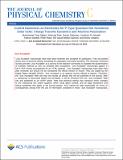CuSCN nanowires as electrodes for p-type quantum dot sensitized solar cells : charge transfer dynamics and alumina passivation
Abstract
Quantum dot sensitized solar cells (QDSSCs) are a promising photovoltaic technology due to their low cost and simplicity of fabrication. Most QDSSCs have an n-type configuration with electron injection from QDs into TiO2, which generally leads to unbalanced charge transport (slower hole transfer rate) limiting their efficiency and stability. We have previously demonstrated that p-type (inverted) QD sensitized cells have the potential to solve this problem. Here we show for the first time that electrodeposited CuSCN nanowires can be used as a p-type nanostructured electrode for p-QDSSCs. We demonstrate their efficient sensitization by heavy metal free CuInSxSe2-x quantum dots. Photophysical studies show efficient and fast hole injection from the excited QDs into the CuSCN nanowires. The transfer rate is strongly time dependent but the average rate of 2.5 x 109 s-1 is much faster than in previously studied sensitized systems based on NiO. Moreover, we have developed an original experiment allowing us to calculate independently the rates of charge injection and QD regeneration by the electrolyte and thus to determine which of these processes occurs first. The average QD regeneration rate (1.33 x 109 s-1 ) is in the same range as the hole injection rate, resulting in an overall balanced charge separation process. To reduce recombination in the sensitized systems and improve their stability, the CuSCN nanowires were coated with thin conformal layers of Al2O3 using atomic layer deposition (ALD) and fully characterized by XPS and EDX. We demonstrate that the alumina layer protects the surface of CuSCN nanowires, reduces charge recombination and increases the overall charge transfer rate up to 1.5 times depending on the thickness of the deposited Al2O3 layer.
Citation
Sajjad , M T , Park , J , Gaboriau , D , Harwell , J R , Odobel , F , Reiss , P , Samuel , I D W & Aldakov , D 2018 , ' CuSCN nanowires as electrodes for p-type quantum dot sensitized solar cells : charge transfer dynamics and alumina passivation ' , Journal of Physical Chemistry C , vol. 122 , no. 9 , pp. 5161-5170 . https://doi.org/10.1021/acs.jpcc.7b12619
Publication
Journal of Physical Chemistry C
Status
Peer reviewed
ISSN
1932-7447Type
Journal article
Description
Funding: European Research Council (grant number 321305) and the EPSRC (grant numbers EP/L017008/1 and EP/M506631/1). IDWS is a Royal Society Wolfson Research Merit award holder.Collections
Items in the St Andrews Research Repository are protected by copyright, with all rights reserved, unless otherwise indicated.

